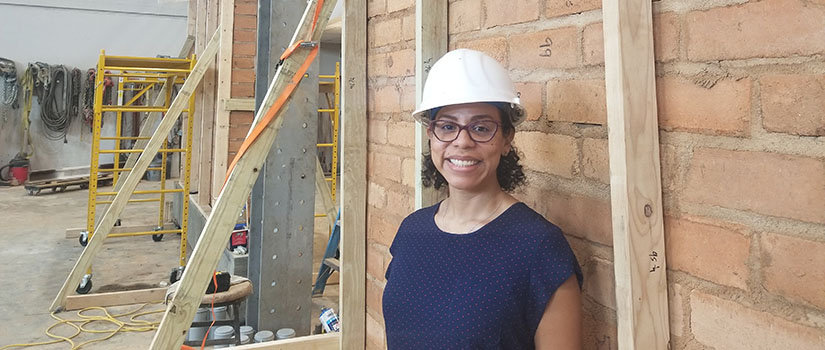The growing demand for high-quality and affordable houses is evident in the U.S. Department of Housing and Urban Development's 2020 Annual Homeless Assessment Report. According to the report, approximately 580,000 people experienced homelessness on a single night in 2020. Recent natural disasters in the U.S. and abroad, such as hurricanes, California wildfires and an earthquake in Haiti highlight the need for hazard-resilient houses.
To help build houses that are more structurally resistant to natural disasters, Civil and Environmental Engineering Professor Fabio Matta and his doctoral student Erika Rengifo-López are preparing to test new wall specimens made of plastic-reinforced, compressed earth bricks to determine if they can resist the impact of earthquakes.
“The materials are cheap and deceivingly perceived as low-quality despite earth’s insulation and humidity-control capabilities,” Matta says. “The beauty of research is that through science and engineering, we can turn locally available, low-cost and low-strength materials into construction that is safe, comfortable and exceptionally resilient; on par or better than traditional and more expensive solutions.”
The current research is an extension of Matta’s work from 2011 to 2015 with funding from the National Science Foundation (NSF) and internal University of South Carolina programs. Matta and his research team prototyped walls built with the same plastic-reinforced, compressed earth bricks. The bricks were made with local South Carolina soil, a small amount of cement, and plastic strips from recycled bottles that could resist the extreme winds and flying debris of hurricanes and tornadoes. Former doctoral candidate Mabel Cuéllar-Azcárate successfully demonstrated the walls’ resistance to flying debris by testing them using a cannon at the College of Engineering and Computing’s structures and materials laboratory.
“This is perhaps the most exciting area of my work since I joined the college [in 2010].”
– Fabio Matta, Civil and Enviromental Engineering
Based on the success of the prototype bricks for hurricane and tornado resistance, Matta and his graduate and undergraduate assistants wanted to investigate if the walls used to build low-rise buildings could also be earthquake resistant. “We expect our walls to provide the strength as well as the damage tolerance to safely withstand earthquake forces. Large cracks will form but the wall won’t topple, thanks to the plastic strips that hold the bricks together,” Matta says.
Undergraduate assistants are responsible for the manufacturing and testing of the bricks in the laboratory. After collecting the soil from a pit in nearby Lexington, South Carolina, the soil is sieved, crushed, and mixed with small amounts of cement, water and plastic strips before being placed into a hydraulic press to complete production.
Walls made with and without plastic reinforcement are being built and tested. In collaboration with Professor Michele Barbato’s team at the University of California, Davis, a new computational model was developed to simulate the response under seismic loads. This could eventually lead to building safe and affordable housing in earthquake-prone areas.
“We are building full-scale, 3-by-3-meter walls. A hydraulic jack will simulate the load from the top, such as a second floor or roof, while another jack simulates horizontal forces that represent ground motions,” Matta says. “We will take the walls down to failure and see how they perform and how well we can predict their behavior. In other words, we’ll verify if they are safe and if we understand them enough to design them.”
Much of the research development and testing is being completed by undergraduate and graduate research assistants. Rengifo-López is currently overseeing the preparation of the blocks and the design and construction of the wall specimens, which are scheduled for testing this fall.
“We’ll keep pushing and pulling the walls horizontally by progressively increasing the forces we impart,” Rengifo says. “We expect that the walls won’t fall apart after cracking and reaching the maximum load they can carry. This is an important feature because the ability to carry some load after the seismic event without collapsing allows people to evacuate or facilitate rescues.”
In collaboration with Mechanical Engineering Professor Michael Sutton, Matta’s team will also use digital image correlation (DIC) to measure deformations on the entire surface of each wall. DIC is a technique that uses digital cameras to take pictures of the walls as they are loaded. The walls will be painted with black dots to give the needed contrast.
“We’ll track the position of every dot on the wall at different loads,” Rengifo says. “Then we’ll use the data to accurately calculate deformations anywhere on the wall’s surface. We have certain expectations based on hypotheses we’re testing, and we’ll learn about the effectiveness of our materials and earthquake-resistant design.”
Matta is excited that the prototype earth masonry can not only withstand the effects of hurricanes, tornadoes and potentially earthquakes, but how the research and development combines all the dream properties for a modern engineer: green construction, affordability, comfort and resistance to extreme forces.
“Students can relate to this work, and that’s why the undergraduate assistants we recruited over the years shared this excitement,” Matta says. “From a teaching perspective, this work is precious to me because it shows how engineering knowledge and understanding make a difference, in this case, beyond the use of high-tech or expensive materials. You have to use it intelligently first.”
